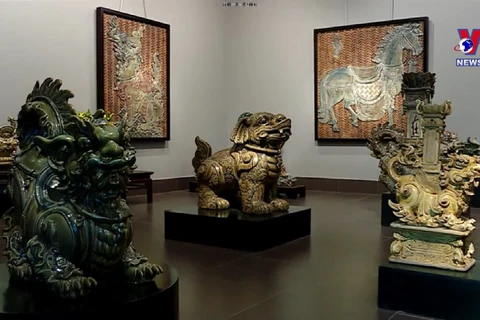Hanoi (VNA) - International economic integration has created positive momentum for market expansion, facilitating the export of traditional products from local craft villages. Nevertheless, the imperative for sustainable development, which entails reducing environmental impact and enhancing energy efficiency, also necessitates the restructuring and enhancement of competitiveness in this field.
Environmentally-friendly production
The rice vermicelli making village of Phu Do has to deal with environmental difficulties. The adoption of technology and advanced equipment has led to notable improvements in productivity and the resolution of environmental concerns.
The chairman of the Phu Do rice vermicelli craft village association, Nguyen Van Hoa, highlights that the transition from coal to electricity has enabled households to increase their daily production capacity by nearly tenfold.
Similarly, transition from coal to electricity in production has also been applied in Phu Vinh Bamboo and Rattan Village in Phu Nghia commune, Chuong My district. Local businesses have gained remarkable economic benefits thanks to reducing production cost while addressing environmental concerns.
Phu Vinh Bamboo and Rattan Village in Phu Nghia commune, Chuong My district have also successfully implemented a shift from coal to electricity in their production processes. As a result, local businesses in the area have experienced significant economic advantages by reducing production costs and simultaneously addressing environmental concerns.
 A product made in Phu Vinh traditional craft village in Chuong My district, Hanoi. (Photo: Vietnam+)
A product made in Phu Vinh traditional craft village in Chuong My district, Hanoi. (Photo: Vietnam+) In the past, Bat Trang Pottery Village burned 800 tonnes of coal daily. However, now, over 90 percent of the households in the local area have adopted advanced methods in producing pottery items. Ha Thi Vinh, Director General of the Quang Vinh Ceramic Company, states that the implementation of technology has resulted in a reduction of over 30 percent in the price of products, while simultaneously enhancing production efficiency. This improvement has greatly increased the company's competitiveness.
Environmentally friendly production is imperative
The recent economic growth of traditional craft villages has showcased the impact of using alternative energy and applying technology in ensuring sustainable practices in the village.
The Hanoi Department of Industry and Trade reports that most of the equipment currently utilized in craft villages consists of basic machines and tools, with advanced machinery being limited to a small number of villages in specific fields such as weaving, sewing, and ceramics. Certain craft village areas lack sufficient investment in wastewater treatment facilities.
Hanoi has implemented numerous programs and projects aimed at promoting the use of energy-saving and efficient methods. They have also focused on utilising alternative energy sources to reduce costs and improve the environment in craft villages. Thanks to the shift towards environmentally-friendly production, the living standards of residents in many craft villages have improved.
Regarding environmental protection solutions for craft villages, Acting Director of the Hanoi Department of Industry and Trade Tran Thi Phuong Lan suggested the need for planning that integrates environmental protection measures, and combining tourism activities with craft production. It is also important to concentrate on industrial zones in rural areas, following the model of small and medium-sized industrial clusters.
The planning agenda should encompass the reconfiguration of production spaces, as well as the planning and construction of waste treatment systems. Additionally, policies should be developed to incentivize and support craft villages, such as reducing taxes and fees for establishments that excel in environmental protection. Furthermore, establishments that invest in environmental protection or contribute to environmental improvement projects should be provided with capital support through the establishment of an environmental protection fund.
Since 2016, the City Industrial Promotion Programme has provided support to numerous rural industrial establishments in their efforts to invest in innovative equipment and adopt scientific and technical advancements for production purposes. This support has led to improvements in productivity and a reduction in environmental pollution.
Significantly, projects aimed at promoting the use of technology in production have proven to be largely successful. This can be attributed to the diligent assessment and selection of beneficiaries and viable projects. The emphasis has been on projects that exhibit substantial scale and impact. This initiative also serves to encourage rural industrial establishments to invest in new production lines and equipment, expand their production capacity, and adopt scientific and technical advancements to enhance production, improve quality, and environmental protection.
According to Luu Duy Dan, Chairman of the Vietnam Craft Village Association, developing brand recognition for traditional craft village products is a viable approach to enhance competitiveness.
Furthermore, he suggested that businesses should foster collaborations to leverage strengths in brand building and promoting craft village products. By doing so, they can effectively cater to the growing demands of the market.
In addition to investing in technological advancements, it is essential for local governments to act as intermediaries, facilitating the exchange of knowledge and technology between craft village households in adopting advanced production techniques, and improving overall technological capabilities./.

























